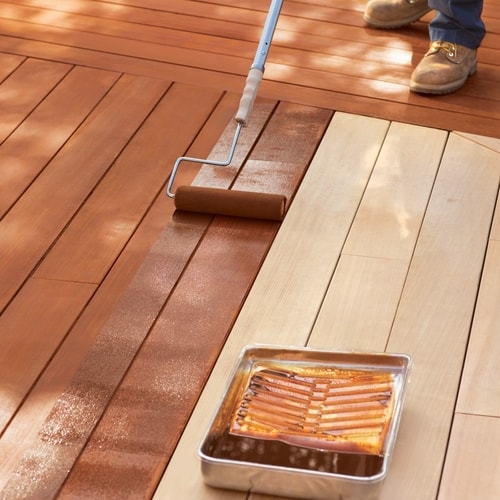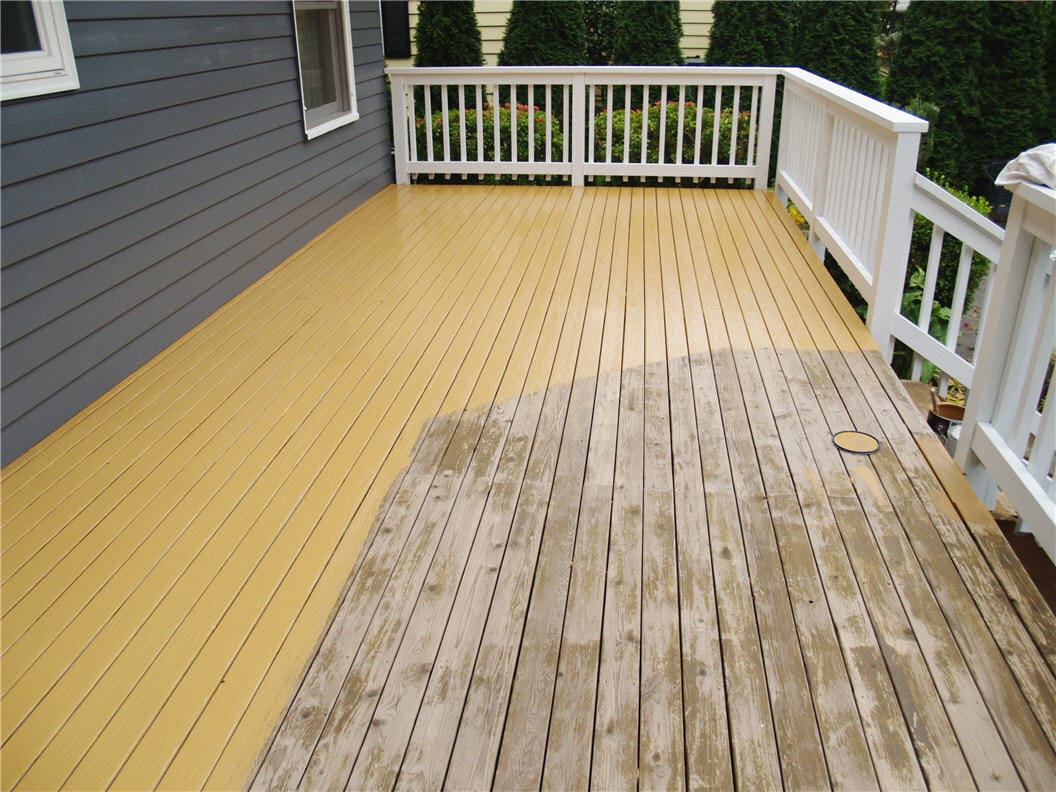Deck Staining Excellence: Nurturing Your Exterior Retreat
Wiki Article
Selecting the Right Stain for Your Fence: Tips and Factors To Consider
When it involves preserving and enhancing the appearance of your fencing, selecting the ideal tarnish is crucial. With a vast variety of options readily available, it can be frustrating to determine which discolor will ideal suit your needs. This guide will provide you with factors to consider and pointers to help you make a notified choice. We will explore the various sorts of fencing stains, variables to consider before choosing a tarnish, pointers for preparing your fence for discoloration, and the differences between oil-based and water-based stains. In addition, we will look into picking the right discolor color to enhance your fencing and enhance your outside space. By following these standards, you can ensure that your fencing continues to be safeguarded and aesthetically pleasing for many years to come.Comprehending Various Sorts Of Fencing Discolorations

On the other hand, water-based discolorations are made from acrylic or latex and provide an extra refined shade to the wood. They create a safety film externally of the wood, preventing moisture from seeping in and shielding versus UV damages. Water-based spots are simpler to clean up and have a faster drying time compared to oil-based discolorations. They are also less most likely to break or discolor in time.
Choosing between water-based and oil-based discolorations depends on different elements, consisting of individual choice, the desired appearance, and the degree of maintenance called for. Oil-based spots are recommended for surround high-traffic locations or those continuously subjected to extreme climate conditions. fence staining. Water-based spots, on the other hand, are a prominent choice for fencings in household areas where appearance and simplicity of use are essential
Comprehending the differences between water-based and oil-based stains assists house owners make an informed choice when picking the ideal stain for their fence. Thinking about the particular requirements of the fencing, such as its place, exposure to sunshine, and preferred aesthetic, will make certain that the chosen stain supplies lasting security and improves the general elegance of the fence.
Aspects to Think About Before Selecting a Discoloration
:max_bytes(150000):strip_icc()/Wooddeckpaintstain-GettyImages-155145295-597560af054ad90010f80913.jpg)
Another element to consider is the kind of wood your fence is constructed from. Different types of timber absorb spots in different ways, leading to varying degrees of color strength and toughness. For instance, softwoods like want may call for more regular staining contrasted to woods like cedar or redwood. In addition, particular woods might be more susceptible to issues like rot or insect infestation, which might impact the selection of tarnish to preserve the fencing and secure.
The environment and weather in your area should additionally be taken right into account. If you reside in a location with extreme winters or high moisture, you might require a discolor that gives additional protection against dampness and UV rays. Furthermore, if your fence is revealed to direct sunlight for lengthy periods, a stain with UV preventions can help prevent fading and staining.
Finally, it is essential to consider your wanted visual. Different spots use different colors and surfaces, enabling you to personalize the look of your fence (fence staining). Think about the total design and style of your home, along with any kind of regional regulations or property owner organization standards that might determine the appropriate discolor colors
Tips for Preparing Your Fence for Discoloration
Cleansing the fence is a crucial action as it eliminates dirt, crud, and any kind of previous coatings that may interfere with the staining procedure. Scrub the surface area carefully, paying extra attention to locations with stubborn discolorations or mold and mildew.After cleaning, allow the fence to completely dry totally. fence staining. This step is important as discoloring a wet or wet surface area can cause bad bond and an unequal finish. Depending on the climate condition, it might take anywhere from a couple of hours to a couple of days for the fence to dry thoroughly. Make sure that the fencing is entirely dry before waging the discoloration process.
Before staining, check the fencing for any type of damages, such as loosened boards or nails. Repair any problems to ensure that the fence is structurally sound. In addition, consider applying a timber conditioner or brightener to the surface area. This item helps to open the timber pores, permitting the discolor to permeate much more effectively and uniformly.

Contrasting Oil-Based and Water-Based Discolorations
When choosing a discolor for your fencing, it is important to compare the qualities and advantages of oil-based and water-based stains. Both sorts of spots have their very own advantages and considerations, so it is critical to understand the differences between them.Oil-based spots are understood for their longevity and resistance to tear and use. In addition, oil-based discolorations often tend to last longer than water-based spots, making them a popular choice for fencings.
On the various other hand, water-based discolorations are more environmentally friendly and simpler to clean up. They have a lower VOC (unstable organic compound) web content, which suggests they launch less damaging fumes right into the air. Water-based spots also dry much faster, permitting for a quicker application and much less downtime. Nonetheless, they might not supply the exact same level of defense as oil-based discolorations, particularly in extreme weather.
Eventually, the option in between water-based and oil-based spots depends on your specific demands and preferences. Consider variables such as longevity, environmental impact, and simplicity of application when making your decision. Consulting with a professional or looking for recommendations from professionals can also assist make certain that you select the best tarnish for your fence.
Selecting the Right Stain Color for Your Fencing
The selection of an ideal discolor shade for your fence is a crucial facet of enhancing its visual charm and complementing the general layout of your outdoor area (deck staining companies near me). The ideal stain shade can transform a level, common fence into a striking centerpiece that adds deepness and character to your propertyWhen selecting a stain shade for your fence, it is necessary to think about the style and design of your home. Earthy tones such as neutrals and browns can develop a warm and welcoming appearance if you have a classic or typical style home. On the other hand, if you have a modern-day or contemporary home, you might think about selecting vibrant and vibrant colors that make a statement.
An additional factor to consider is the all-natural surroundings of your building. If you have a lot of greenery, a discolor shade that enhances the natural landscape, such as eco-friendlies or crimsons, can create a natural and unified appearance.
In addition, it's worth taking into consideration the upkeep needed for different stain colors. Lighter colors often tend to show dirt and wear more quickly, while darker colors can hide flaws and call for much less constant touch-ups.
Ultimately, the choice of tarnish color for your fencing should reflect your personal style and preferences - deck staining nashville tn. Take the time to speak with and check out various options with experts if needed, to make certain that you select the ideal tarnish shade that enhances the charm and appeal of your fence
Final Thought
In conclusion, when it pertains to picking the right stain for your fence, it is essential to understand the different kinds of spots readily available and consider elements such as durability and desired appearance. Preparing the fence appropriately prior to discoloration is critical for achieving optimal results. Additionally, comparing water-based and oil-based discolorations can aid establish the ideal alternative for your specific needs. Picking the appropriate tarnish shade can improve the overall visual appeals of your fence.We will discover the different types of fencing find this spots, factors to consider prior to choosing a tarnish, ideas for preparing your fence for discoloration, and the distinctions between water-based and oil-based spots.Distinguishing in between oil-based and water-based discolorations is crucial when understanding various types of fence stains. Water-based spots are easier to cleanse up and have a much faster drying out time compared to oil-based discolorations. Furthermore, oil-based discolorations have a tendency to last longer than water-based discolorations, making them a prominent selection for fencings.
In conclusion, when it comes to choosing the appropriate stain for your fencing, it is important to comprehend the various types of stains offered and consider elements such as resilience and preferred look.
Report this wiki page